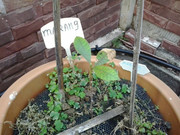
This is my other marang, i had one more but it died. Is this sick poor thing a real marang? It is in shade most of the day
Yes, this is real marang. It does look sick. Some seedlings are like children with Down syndrome. Will never reach full potential, despite repeated pampering. You better start off with a new batch, and select the strongest seedlings. Also it is far better to have them under 60% shade cloth than expose them to full Bangkok's sun for a few hours when it hits 30 C. Plant will suffer despite being in shade most of the day.
The abiu "marang" also looked sick but this one survived it. Also the pingan i have some that look the same as this sick marang. I had 10 marangseeds but kept only 3 myself unfortunately

Well i don't start over with marang, better go for keledang because the smell will give problems here. Also people from bangkok don't like the chempedak because it's smell and i also can't stand it. I just let this sick one in this pot and hopefully it gets over it one day.
The pedalai gets 38 celcius every day normally. Now it's very cold here and in the shade 29 today. I keep it in full sun, have plenty other pedalai in the shade, too many actually so i 'm giving them away allready but nobody wants it haha. They first want to taste the fruit. I will use them for experiments to make cocktailtree's.
But i ate jackfruit pet raa chaa today and boy is that a perfect fruit. I really don't know what could be improved on it, i give it a 10 out of 10 but it has to be fully ripe and still crispy like now and sweet as namdocmai green.
If keledang or pedalai is even better then sure i will replace it for my big pet raa chaa tree and build a electric fence around it with many securitycamera's and 2 Rottweilers connected to the tree

Then also the durian will be replaced but i first have to eat them because i can't believe they are that good.

